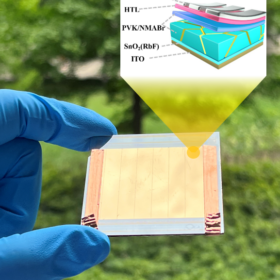Aira launches residential heat pump with minimalist design
The Sweden-based heat pump provider said its new product is one of the slimmest and most compact system available on the market to date.
Solar brick based on perovskite, textile ceramic technology
A European research team has sought to combine for the first time perovskite solar cell technology with textile ceramic in a novel building-integrated photovoltaic device. The result is a solar brick with potential for future commercialiation, according to its creators.
‘There is no such thing as a global patent’
Jeffrey Saltman, partner at US intellectual property law firm Fisch Sigler LLP, recently spoke to pv magazine about the rising number of patent lawsuits between PV module manufacturers. He said this increase in litigation mainly stems from the industry’s convergence on tunnel oxide passivated contact (TOPCon) tech and noted that the number of lawsuits is likely to rise in the near future.
Grid-resilient inverters are exposed to cyber-physical threats
New research shows all the challenges that smart inverters will have to face in the next decades, including cybersecurity issues and increasing manufacturing costs. The scientists explain that, despite the new opportunities that the Internet of Things and artificial intelligence are offering, their application may also result in an increasing number of cyber risks.
New design guidelines for integrated photovoltaics
A Belgian-Dutch research team has defined new design guidelines for photovoltaics integrated in buildings or infrastructures. The proposed approach, which was validated through two demonstators, supports the manufacturing of semi-fabricates for integrated photovoltaics applications by enabling effective communication between project developers and module producers.
Perovskite solar cell based on lead iodide treated with 4-fluorobenzylamine achieves 23.62% efficiency
By regulating the secondary growth of lead iodide, an international group of scientists has built a perovskite solar cell with low non-radiative recombination and defect state density. The device reportedly exhibited superior stability in both humidity and thermal stability tests compared to reference cells.
2D modeling to deploy bifacial PV plants with single-axis trackers on sloping terrain
Developed by Spanish scientists, the proposed model is intended to reduce yield losses caused by the fact that north-south aligned single-axis trackers are often deployed on uneven east-west slopes.
Mitigation strategies against islanding in grid-connected PV systems
Researchers in India have proposed a new set of techniques to mitigate total harmonic distortions during islanding events, which occur in distributed generation systems when there are disruptions in the power grid. Compared to conventional approaches, it reportedly achieves faster detection times by leveraging real-time data analytics and dynamically adjusting to changing grid conditions.
New tech to recover high-purity silicon powder from end-of-life solar panels
Korean researchers have used thermal and wet gravity separation (WGS) to separate EVA from reclaimed silicon powder in end-of-life PV modules with “minimal” chemical usage. The proposed technique provides silicon powder that could be reused as a raw material for upcycling into silicon nitride, silicon oxide, or silicon carbide.
Around 40% of PV plants deployed in Germany are close to transport routes
A group of researchers have investigated the influence of the regulatory framework on supporting the expansion of ground-mounted PV plants close to transport routes as railways, highway and federal roads in Germany. Their analysis showed that most of the PV systems installed next to these routes are located on what was once agricultural land.










